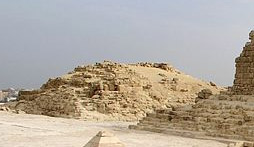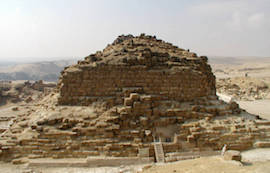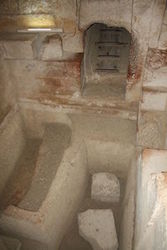There are three satellite pyramids on the north side of the Great Pyramid of Giza, which are often referred to as the Queen’s Pyramids.

G1a: Queen Hetepheres
The northern-most pyramid (G1a) was originally ascribed to Queen Meritetes (or Mertitiotes), but is now considered to be the secondary burial of Queen Hetepheres I . It originally stood 30.25 meters high, but lost its outer casing and about two-thirds of its height. It was composed of a yellow limestone core in three or four steps encased in Tura limestone, fragments of which remain.
The entrance is in the north wall, just off the north-south axis. Inside the pyramid, a corridor descends to the mid point of the structure before turning right into a small burial chamber cut into the rock and surfaced with limestone blocks. Although there is a recess carved into the west wall of the chamber, no sarcophagus was found in the tomb.

An alabaster canopic box and jars, complete with residue from the mummification process, were discovered in a hidden compartment. Vyse found fragments of basalt in the burial chamber which he assumed were from a sarcophagus, but they are now thought to have come from the pavement of Khufu’s mortuary temple.

Very few remains of the small mortuary temple that originally stood before the east wall of his pyramid exist, and its archaeological reconstruction is very difficult. There was a small mortuary chapel attached to the pyramid, but little remains.
A small boat pit was discovered to the south of the pyramid, though no trace of any boats has been found. At a later date (possibly in the 26th Dynasty) the pit was divided into compartments and may have become a store room. To the east of the pyramid, a deep burial shaft was discovered filled with numerous precious objects belonging to Queen Hetepheres I .
G1b: Queen Meritites
The second pyramid (G1b) is now ascribed to Queen Meritites, although there is no substantial evidence to support this. Others have suggested that the (unnamed) mother of Djedefre was originally interred in this pyramid. While Meritetes is often cited as the mother of Djedefre, an inscription found on a false door in a nearby mastaba has caused some to doubt that she was buried in G1b.
The inscription on the false door states, “King’s wife, his beloved to Horus, Mertitiotes: beloved of the Favourite of the Two Goddesses; she who says anything whatsoever and it is done for her. Great in the favour of Sneferu; Great in the favour of Khufu, devoted to Horus, honoured under Khafre, Mertitetes“.

The mention of Sneferu and Khufu suggests that the mastaba cannot have been an earlier tomb which was later discarded in favour of G1b.
It sits about ten meters south of G1a, on the same north-south axis, and would have been about 30 meters high. It is similar in construction to G1a; all of the subterranean passages are cut from the rock, and the burial chamber is lined with limestone. Unfortunately, it is also in very poor condition, and the only sign that there was a mortuary chapel are a few markings on the rock. There is evidence of a boat pit to the south of the pyramid in 1953, but it was filled with stone and rubble in order to build a road on the area.
G1c: Queen Henutsen
The southernmost of the three pyramids (G1c) is ascribed to Queen Henutsen. It is similar to the other two small pyramids in construction, but according to Lehner it is the most complete.
However, Reisner claimed that the casing was not finished and although an area seems to have been prepared for a boat pit, it was never excavated. It lies about 3.8 meters south of G1b and is slightly offset to the east. It originally stood 29.62 meters high.

The pyramid is composed of three steps of mastaba like sections. Near the bottom is a packing layer composed of soft yellow limestone, and some of the fine limestone casing is still in place. The burial chamber was also lined with limestone and featured a four centimetre deep niche in the south wall, the purpose of which is unknown.


It seems that G1c was not part of the original ground plan. Its southern side doesn’t line up with the great pyramid, but with a neighbouring double mastaba, which may have belonged to Prince Khafkhufu I (also known as Khafre). To the west of the entrance there are blocks of limestone set at a right angle to the face of the pyramid, although they may have been added some time later.
We have no details on the construction of the mortuary temple which some argue was hastily built using mud-brick by Shepseskaf . The structure had been destroyed by the middle kingdom and was reconstructed during the 18th dynasty and then altered again during the 21st and 26th dynasties as a cult site for the goddess Isis. The reconstructions retained some of the original wall which was carved to resemble matting (a material used in ancient chapels). The entrance in the east wall is intact, but only one block of limestone remains on the south side. It is carved with a niche design
Bibliography
- Dodson, A and Hilton, D. (2004) The Complete Royal Families of Ancient Egypt
- Lehner, Mark (1997) The Complete Pyramids
- Rice, Michael (1999) Who’s Who in Ancient Egypt
- Verner, Miroslav (1997)The Pyramids
Copyright J Hill 2015
